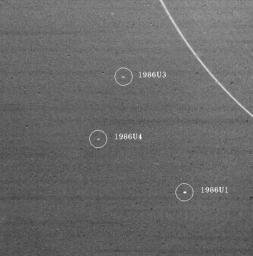
|
Uranus Satellites
- Click the image above for a larger view
- Full-Res JPEG (996 x 1009) (134.5 kB)
- Full-Res TIFF (996 x 1009) (760.7 kB)
Caption:
Three of the newly discovered satellites of Uranus are captured in this Voyager 2 image taken Jan. 18, 1986, when the spacecraft was 7.7 million kilometers (4.8 million miles) from the planet. All three lie outside the orbits of Uranus nine known rings, the outermost of which, the epsilon ring, is seen at upper right. The largest of the three moons viewed here, 1986U1, was discovered Jan. 3; it is an estimated 90 km (55 mi) across and orbits Uranus once every 12 hours 19 minutes at a distance of 66,090 km (41,040 mi) from the planet's center. The other two moons are slightly smaller. 1986U3 orbits once every 11 hours 6 minutes at 61,750 km (38,350 mi), 1986U4 every 13 hours 24 minutes at 69,920 km (43,420 mi). They were discovered on Jan. 9 and 13, respectively. Long exposures were required to bring out these small objects; thus, as a result of the relative motions of the spacecraft and the moons, they appear slightly elongated.
Background Info:
The Voyager project is managed for NASA by the Jet Propulsion Laboratory.
Cataloging Keywords:
| Name | Value | Additional Values |
|---|---|---|
| Target | Uranus Rings | Epsilon Ring, Uranus |
| System | Uranus | |
| Target Type | Ring | Planet |
| Mission | Voyager | |
| Instrument Host | Cassini Orbiter | Voyager 2 |
| Host Type | Orbiter | Flyby Spacecraft |
| Instrument | Imaging Science Subsystem (ISS) | |
| Detector | ||
| Extra Keywords | Grayscale | |
| Acquisition Date | ||
| Release Date | 1996-11-26 | |
| Date in Caption | 1986-01-18 | |
| Image Credit | NASA/JPL | |
| Source | photojournal.jpl.nasa.gov/catalog/PIA00368 | |
| Identifier | PIA00368 | |
